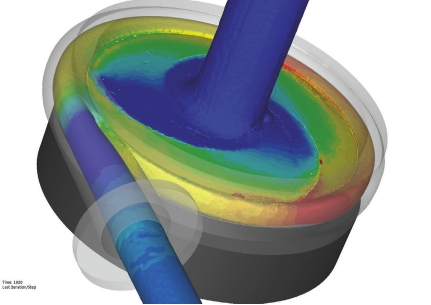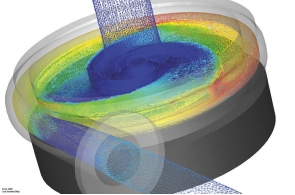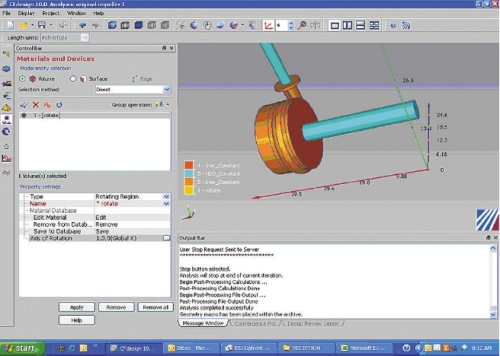


For most engineers, performance claims are like the hype that surrounds a professional sports prospect – the potential is enticing, but engineers have to see the results for themselves. Andrew Enterline, design engineer at Cornell Pump Company, has seen, and he believes. The 50-plus year old company, based in Clackamas, Oregon, USA, has experienced a 100 times performance increase in its upfront CFD simulations using real models. This sort of performance is made possible by a combination of new Motion and HPC Modules developed by Blue Ridge Numerics for its CFdesign simulation software.
“We now have the ability to go from 200 hours of compute time to generate a pump curve simulation to only two hours,” says Enterline.
CFdesign enables users to conduct design studies in the early stages of product development. The real-world simulation capabilities in the software allow engineers to optimize design, placement, and performance of critical components in products such as pumps.
Optimizing design early
Cornell Pump Company is in the business of moving liquids, from clear liquids such as water to industrial sludge. The company’s pumps can be found hard at work for raw water intake, water processing, pressure boosting, refineries, energy recovery, cooling towers, distillation systems, wastewater processing, food processing, dissolved air flotation (DAF) systems, and power plants.
A major emphasis for Cornell and its customers is energy eÿciency. The company manufactures more than 60 clear-liquid and solids-handling pumps that meet or exceed optimum eÿciency standards for centrifugal pumps.
As the company points out on its website, eÿciency savings add up: At 0.7 €/kWh (10 cents/kWh), a 37kW (50 HP) pump costs 2.7 €/hour ($4/hour) to operate. A 2.5% increase in pump eÿciency can save up to 670 €/year ($1,000/year) in energy costs. The global need for energy eÿciency is driving Cornell to optimize its pump designs early in the product development process. That is where CFdesign software comes into the picture, according to Enterline.
“CFdesign helps us reach an optimized design before we pour our castings,” he says. “It saves us time that we would normally use to rework patterns and re-pour castings. It also saves us time when we get to the development stage of physical testing.”
CFdesign software enables designers to put fluid flow and heat transfer simulation upfront in the product development process, cutting the time and expense associated with physical prototyping and testing, and creating more time and resources for activities related to product innovation.
The software allows users to set up single- or multi-scenario flow and thermal design studies to assess performance against competing designs or specified critical values. A Design Review Center within the software uses easy-to-understand 3D visualizations that help simplify and sharpen decision-making, providing insight not available in lab or physical testing.
CFdesign automated features
Pump manufacturers such as Cornell use CFdesign to simulate and optimize design, placement and performance of critical components and systems on a digital drawing board. The software provides automated features for the following pump design tasks:
• Optimizing blade profile, pitch and number of blades.
• Optimizing volute shape to best suit the rotating device.
• Developing flow capacity and eÿciency curves.
• Identifying required hydraulic torque and power.
• Identifying both steady state and transient rotational speeds for flow-driven applications.
• Gathering a quick insight into every detail of the compressor/scroll or impeller/volute combinations.
• Determining periodic boundary conditions for a detailed analysis of one blade set.
• Conducting full machine analysis using native CAD models without losing geometry accuracy to a neutral file.
• Generating full performance curves and eÿciency plots in days, rather than waiting months for a prototype to be built and tested.
• Discovering details of the flow separation, inlet angles, scroll exit profiles, shear stresses, stator vanes, and complex split volutes in the CAD model, as well as visualizing data obtained on a flow bench.
From 200 hours to two hours
Using CFdesign and the new Motion Module, Cornell design engineers performed a series of transient simulations to develop a complete performance curve, enabling evaluation of a centrifugal pump design in only two hours, down from 200 hours. This resulted in a significant reduction in product development time.
The CFdesign Motion Module allows users to create a virtual prototyping environment that simulates the way components interact and respond to prescribed flows. All of the physical effects of the motion, as well as the time-history, are output for data review and to create animations for visual studies.
Like CFdesign, the Motion Module is fully integrated with popular 3D CAD systems, including Autodesk Inventor, CATIA, CoCreate, NX, Pro/ENGINEER, SolidWorks, Solid Edge, and SpaceClaim. This makes it easy to bring the CAD model into Motion Module and immediately begin multiple iterations between design changes and simulations until an optimal solution is reached. Claimed unique characteristics of the Motion Module include:
• It uses a superior ‘sliding mesh’ instead of a frozen rotor approach for rotating regions on pumps, fans and turbines.
• It provides a full complement of solid body motion definitions, from linear and angular to orbital, nutating (irregular), sliding vane and free motion.
• Motion can either be strictly enforced or flow-driven.
• It includes a built-in time step calculator.
• The preview capability permits users to quickly validate the range of motion before running a simulation.
• It automatically outputs all hydraulic forces and torques on moving bodies.
More understanding
The combination of CFdesign and the Motion Module enables engineers at companies such as Cornell Pump to achieve the following: • Understand the flow and temperature behavior of the flow as one or more objects move through a prescribed path at a certain rate.
• Determine how much flow is required to set an object in motion, or bring it to a stop.
• Understand the path of the object, and simulate it bouncing off other objects.
• View side-by-side design comparisons to determine appropriate spring sizes needed to prevent movement below a threshold flow.
• Run scenarios to compute the bearing forces from orbital (whirling) motion because of shaft imbalance in pumps.
• Evaluate the performance of turbomachinery devices such as pumps, turbines and blowers, and even multi-component devices such as automotive torque converters.
In the past, design teams have typically had to choose between a slower simulation time for a full system-level transient model simulation, or a less accurate fixed-rotor approach. With the new capabilities in the Motion Module, CFdesign design teams no longer have to sacrifice accuracy for speed. Before the release of CFdesign with the updated Motion Module, generating a typical pump curve for the Cornell design team required 300 iterations at 1.5 iterations/hour. This was just to evaluate a single design. The team sorely needed a faster solution.
New rotational algorithms for transient rotating modeling included in the latest release of the Motion Module helped speed up simulation time by 20X on a standard desktop computer, allowing Cornell and other design teams to more quickly and accurately evaluate performance curves. By combining the Motion Module with CFdesign’s HPC Module for high-performance computing, Cornell Pumps was able to achieve an overall 100X speed-up.
The HPC Module harnesses the power of Windows HPC networks, whether in a data center or a smaller cluster environment. Users can complete more design studies in less time and arrive at solutions much quicker for large, complex models. Cornell conducted simulations on an eight-node HPC cluster, but speed increases dramatically on even the most basic clusters.
“HPC brings huge value and offers many configuration alternatives,” says Ed Williams, president of Blue Ridge Numerics. “When people think HPC, they often think big hardware and big hardware costs. But even a modest two-computer Windows HPC mini-cluster with our HPC Module creates enough ‘horsepower’ to speed up solution times by up to 400%.”
The performance increases that the Cornell team experienced using CFdesign and the two modules will have major implications for development of new pumps. Beyond cutting computer simulation time from weeks to hours, it is expected to reduce the number of pump castings that have to be made for physical testing. Eliminating just one of the physical tests could save the Cornell team as much as three months of development time.
“With much faster running speeds, we will be able to do many more simulation runs in less time,” says Enterline. “We’ll spend more time designing the product and less time and money in pattern rework, re-pouring castings, and physical development testing, helping us create more optimized product designs from the start.”





